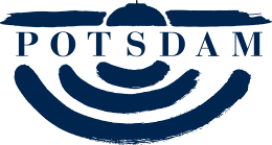Ein Blick durch die stark beschädigte Fassade der Hauptpost am Platz der Einheit auf die Kaiserbrücke (mit Straßenbahnschienen) und die Nauener Brücke des Stadtkanals (im Hintergrund). Trotz schwerer Kriegsschäden ist die alte Stadtstruktur noch gut erkennbar.
1755/56 nahm Friedrich II. (1712–1786) die Neugestaltung der Südseite der damaligen Nauener Plantage in Angriff und es entstanden jene Manufakturgebäude, die am linken Bildrand erkennbar sind. Hier waren unter anderem eine Strohhut- und eine Seidenfabrik ansässig. Zehn Jahre später erhielt auch der Stadtkanal sein bis zur Zuschüttung charakteristisches Aussehen mit gemauerten Uferwänden, Sandsteintreppen und den gusseisernen Gittern. Seit dem Neubau der Langen Brücke 1880 fand am platzseitigen Ufer des Kanals auch der berühmte Potsdamer Fischmarkt statt.
Der Turm der Garnisonkirche überragt das Panorama, darunter das Eckhaus von 1764.
Zunächst beherbergte es einen Teil der in mehren Häusern am Kanal ansässigen Seidenmanufaktur des jüdischen Unternehmers Isaak Bernhard (Beermann Isaak Zültz, Lebensdaten unbekannt). Ab 1788 wurden in dem Haus dann Bögen und Saiten für Violinen hergestellt und 1861 gründetet Louis Parlasca hier sein Spezialgeschäft für Damenkleiderstoffe und Manufakturwaren mit eigenem Atelier. Heute befindet sich das 1958 neu errichtete Wohnhaus mit dem Einrichtungshaus More Wolf.
Interessant sind auch die Verkehrsschilder am unteren Bildrand. In kyrillischer Schrift weisen sie den sowjetischen Besatzungstruppen den Weg nach Babelsberg, Frankfurt und Breslau.
----- ----- ----- ----- -----
A view through the badly damaged façade of the main post office on Platz der Einheit square to the Kaiser Bridge (with tram tracks) and the Nauen Bridge (in the background) of the city canal. Despite severe war damage, the old city structure is still clearly recognisable.
In 1755/56, Frederick II (1712-1786) set about redesigning the south side of the former Nauen plantation and the factory buildings that can be seen on the left-hand side of the picture were built. Among other things, a straw hat factory and a silk factory were located here. Ten years later, the city canal was also given its characteristic appearance with brick walls, sandstone steps and cast-iron grilles, which it would retain until it was filled in in the 1960s. Since the Lange Brücke bridge was built in 1880, the famous Potsdam fish market has also been held on the square side of the canal.
The tower of the Garrison Church towers above the panorama, below it the corner house from 1764, which initially housed part of the silk manufactory
A view through the badly damaged façade of the main post office on Platz der Einheit square to the Kaiser Bridge (with tram tracks) and the Nauen Bridge (in the background) of the city canal. Despite severe war damage, the old city structure is still clearly recognisable.
In 1755/56, Frederick II (1712-1786) set about redesigning the south side of the former Nauen plantation and the factory buildings that can be seen on the left-hand side of the picture were built. Among other things, a straw hat factory and a silk factory were located here. Ten years later, the city canal was also given its characteristic appearance with brick walls, sandstone steps and cast-iron grilles, which it would retain until it was filled in in the 1960s. Since the Lange Brücke bridge was built in 1880, the famous Potsdam fish market has also been held on the square side of the canal.
The tower of the Garrison Church towers above the panorama, below it the corner house from 1764, which initially housed part of the silk manufactory of the Jewish entrepreneur Isaak Bernhard (Beermann Isaak Zültz, biographical data unknown) located in several houses along the canal. From 1788, bows and strings for violins were manufactured in the house and in 1861 Louis Parlasca founded his speciality shop for women's clothing fabrics and manufactured goods with his own atelier here. Today, the house is home to the More Wolf furniture store, which was newly built in 1958.
The road signs at the picture's lower edge are also interesting. In Cyrillic script, they show the Soviet occupation troops the way to the Babelsberg district and the cities of Frankfurt [Oder] and Wrocław (now Wrocław in Poland).


